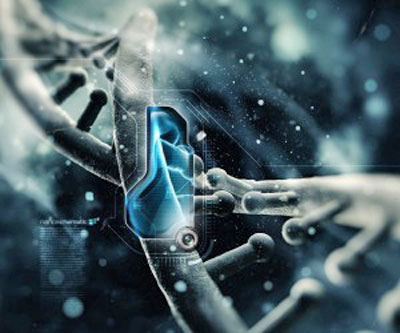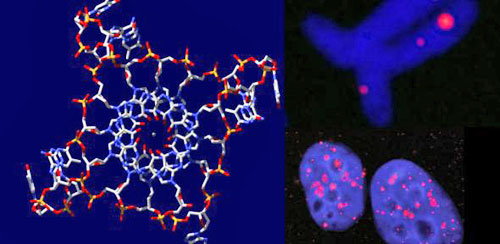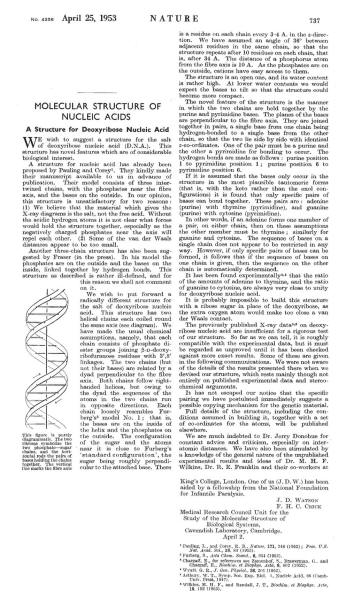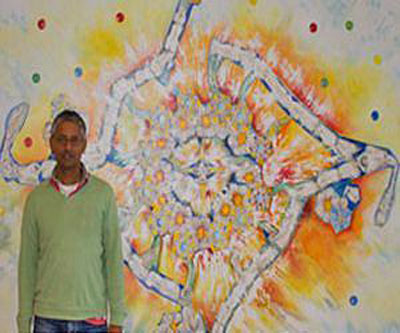|

July 17, 2013
from
Collective-Evolution Website

The human race knows very little of
itself, almost like a race with amnesia.
As we continue to move forward through
time, new discoveries are made that make old theories obsolete and
false. It’s a good lesson that shows us how we can attach ourselves
to “truths” and believe them whole-heartedly, often forgetting that
truth is constantly changing and new paradigms of perception always
lurk around the corner.
Decades after scientists described our “chemical code” of life using
the double helix DNA, researchers have discovered four-stranded
DNA within human cells.
The structures are
called G-quadruplexes, because they
form in regions of DNA that are full of
guanine, one of the DNA molecule’s
four building blocks. The others are adenine, cytosine and thymine.
A hydrogen bond is responsible for holding the four guanines
together.
The four stranded DNA usually presents
itself right before cell division. The discovery was published
online in Nature Chemistry, and you can
take a look at it here.
The study was led by Shankar
Balasubramanian at the University of Cambridge, UK.
For us, it strongly supports a new
paradigm to be investigated - using these four-stranded
structures as targets for personalized treatments in the future.
We have found that by trapping the
quadruplex DNA with synthetic molecules we can sequester and
stabilize them, providing important insights into how we might
grind cell division to a halt.
Shankar Balasubramanian
The study went on to show certain links
between concentrations of four-stranded G-quandruplexes and the
process of DNA replication, which is crucial to cell division and
cell production.
G-quadruplexes, (when targeted with
synthetic molecules responsible for trapping and holding these DNA
structures) prevent cells from replicating their DNA, thus blocking
cell division.
Scientists believe that this discovery
could possibly lead to a stop in cell proliferation at the root
of cancer.
We are seeing links between trapping
the G-quadruplexes with molecules and the ability to stop cells
dividing, which is hugely exciting. The research indicates that
G-quadruplexes are more likely to occur in genes of cells that
are rapidly dividing such as cancer cells.
It’s been sixty years since its
structure was solved but work like this shows us that the story
of DNA continues to twist and turn”.
Shankar Balasubramanian
We now know that G-quandruplexes form in
the DNA of human cells.
If anybody had mentioned this earlier,
they would probably be labeled as crazy. Maybe we could take
this as a lesson and accept the fact that there are always
new discoveries to be made about our biology, as well as the nature
of our reality.
For all we know, our DNA,
-
Could be multidimensional in
nature?
-
Could it be 12 stranded DNA?
-
Maybe we have yet to discover
it?
-
Maybe a majority of our DNA, and
the biological functions it serves are largely undiscovered?
-
Maybe some portions of our DNA
have yet to be activated?
The more we discover about our own
biology, the better, as we are witnessing with the discovery of the
G-quandruplex.
Sources
Four-Stranded ‘Quadruple Helix’ DNA
Structure
...Proven
to Exist in Human Cells
by Fred Lewsey
31 January 2013
from
UniversityOfCambridge Website
|
For more information on this
story, please contact Fred Lewsey (fred.lewsey@admin.cam.ac.uk)
at the University of Cambridge Office of External
Affairs and Communications. |

Quadruplex
visualization and staining in human cell nuclei and chromosomes
Credit: Jean-Paul Rodriguez and Giulia Biffi
Discovery opens up possibilities for a new generation of targeted
therapies for cancer.
For us, it strongly supports a new paradigm to be investigated -
using these four-stranded structures as targets for personalized
treatments in the future.
Shankar Balasubramanian
In 1953, Cambridge researchers Watson and Crick
published a paper describing the interweaving ‘double helix’ DNA
structure (click below image) - the chemical code for all life.

Source
Now, in the year of that scientific landmark’s 60th
Anniversary, Cambridge researchers have published a paper proving
that four-stranded ‘quadruple helix’ DNA structures - known as G-quadruplexes
- also exist within the human genome.
They form in regions of DNA that are
rich in the building block guanine, usually abbreviated to
‘G’.
The findings mark the culmination of over 10 years investigation by
scientists to show these complex structures in vivo - in living
human cells - working from the hypothetical, through computational
modeling to synthetic lab experiments and finally the identification
in human cancer cells using fluorescent biomarkers.
The research, published today in Nature Chemistry (Quantitative
Visualization of DNA G-Quadruplex Structures in Human Cells)
and funded by Cancer Research UK, goes on to show clear links
between concentrations of four-stranded quadruplexes and the process
of DNA replication, which is pivotal to cell division and
production.
By targeting quadruplexes with synthetic molecules that trap and
contain these DNA structures - preventing cells from replicating
their DNA and consequently blocking cell division - scientists
believe it may be possible to halt the runaway cell proliferation at
the root of cancer.
“We are seeing links between
trapping the quadruplexes with molecules and the ability to stop
cells dividing, which is hugely exciting,” said Professor
Shankar Balasubramanian from the University of Cambridge’s
Department of Chemistry and Cambridge Research Institute, whose
group produced the research.
“The research indicates that
quadruplexes are more likely to occur in genes of cells that are
rapidly dividing, such as cancer cells. For us, it strongly
supports a new paradigm to be investigated - using these
four-stranded structures as targets for personalized treatments
in the future.”
Physical studies over the last couple of
decades had shown that quadruplex DNA can form in vitro - in the
‘test tube’, but the structure was considered to be a curiosity
rather than a feature found in nature.
The researchers now know for the first
time that they actually form in the DNA of human cells.
“This research further highlights
the potential for exploiting these unusual DNA structures to
beat cancer - the next part of this pipeline is to figure out
how to target them in tumor cells,” said Dr Julie Sharp, senior
science information manager at Cancer Research UK.
“It’s been sixty years since its structure was solved but work
like this shows us that the story of DNA continues to twist and
turn.”

Shankar
Balasubramanian in front of a mural in his office
representing
quadruplex DNA, called ‘Living by the code’
by artist Annie
Newman.
The study published today was led by Giulia Biffi, a
researcher in Balasubramaninan’s lab at the Cambridge Research
Institute.
By building on previous research, Biffi was able to generate
antibody proteins that detect and bind to areas in a human genome
rich in quadruplex-structured DNA, proving their existence in living
human cells.
Using fluorescence to mark the antibodies, the researchers could
then identify ‘hot spots’ for the occurrence of four-stranded DNA -
both where in the genome and, critically, at what stage of cell
division.
While quadruplex DNA is found fairly consistently throughout the
genome of human cells and their division cycles, a marked increase
was shown when the fluorescent staining grew more intense during the
‘s-phase’ - the point in a cell cycle where DNA replicates before
the cell divides.
Cancers are usually driven by genes called oncogenes that have
mutated to increase DNA replication - causing cell proliferation to
spiral out of control, and leading to tumorgrowth.
The increased DNA replication rate in oncogenes leads to an
intensity in the quadruplex structures. This means that potentially
damaging cellular activity can be targeted with synthetic molecules
or other forms of treatments.
“We have found that by trapping the
quadruplex DNA with synthetic molecules we can sequester and
stabilise them, providing important insights into how we might
grind cell division to a halt,” said Balasubramanian.
“There is a lot we don’t know yet. One thought is that these
quadruplex structures might be a bit of a nuisance during DNA
replication - like knots or tangles that form.
“Did they evolve for a function? It’s a philosophical question
as to whether they are there by design or not - but they exist
and nature has to deal with them. Maybe by targeting them we are
contributing to the disruption they cause.”
The study showed that if an inhibitor is
used to block DNA replication, quadruplex levels go down - proving
the idea that DNA is dynamic, with structures constantly being
formed and unformed.
The researchers also previously found that an overactive gene with
higher levels of quadruplex DNA is more vulnerable to external
interference.
“The data supports the idea that
certain cancer genes can be usefully interfered with by small
molecules designed to bind specific DNA sequences,” said
Balasubramanian.
“Many current cancer treatments attack DNA, but it’s not clear
what the rules are. We don’t even know where in the genome some
of them react - it can be a scattergun approach.
“The possibility that particular cancer cells harbouring genes
with these motifs can now be targeted, and appear to be more
vulnerable to interference than normal cells, is a thrilling
prospect.
“The ‘quadruple helix’ DNA structure may well be the key to new
ways of selectively inhibiting the proliferation of cancer
cells. The confirmation of its existence in human cells is a
real landmark.”
|




